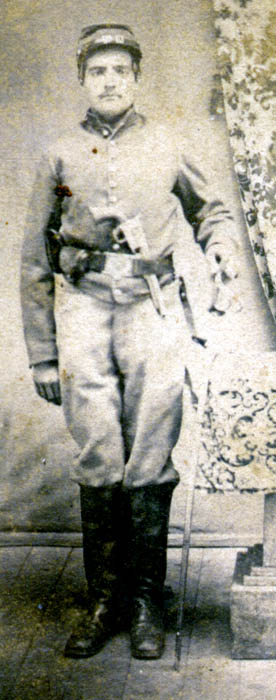Cavalry Enlisted Men's Uniforms

Unknown Cavalry Private

This private of cavalry is wearing a forage cap and cavalry jacket with the top button unbuttoned (strictly against regulations). His saber is held to his left side and a colt revolver is in his belt. He is wearing a sword belt with the sword attached by leather hangers. His cap box is the same as that used by infantry, but his cartridge box is smaller and lighter than those used by infantry. Cavalrymen did not wear a cross belt to support their cartridge box, such as might be seen in an image of a infantryman. Unlike many other images of cavalrymen he wears his boots outside of his cavalry trousers. The 1861 regulations mention the Jefferson boot, which was more of a shoe and the ankle boot, which comes up only a short distance above the ankle. Both of these would be worn under the trousers. This man is wearing a much higher calf type boot outside of his trousers. There is a feeling that these might be issued as well as private purchase, as they are not that uncommon in period images on enlistedmen and were very popular with officers. A properly fitted calf boot does offer much more support to a mounted man's legs than the lower cut boots that the economy minded army had as regulation.
Cavalry performed important duties during the Civil War, but they were never main battle elements like artillery or infantry. They operated on the edges of the army scouting and raiding enemy communications. The cavalryman's experience of combat was mostly small units actions and might be fought mounted or dismounted. Mounted a cavalryman fought with saber or revolver, usually against enemy cavalry. Casualties were often relatively light since both the shooter or wielder and his target were in motion on horseback. It proved to be suicide when cavalry attempted a mounted attack against any sizable body of experienced infantry or against deployed artillery. Small infantry or limbered artillery units might be gobbled up before they were able to offer any resistance by a fast moving and quick thinking cavalry commander. Dismounted and using their carbines cavalry fought like infantry skirmishers. They might defend against infantry units in a holding action or attack a target of opportunity along the enemy's line of communications while on a raid.